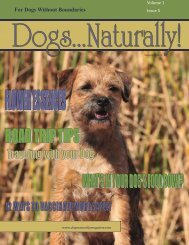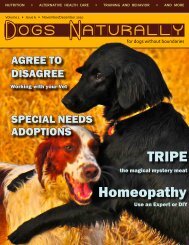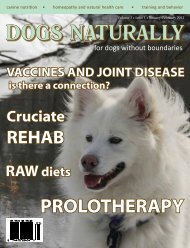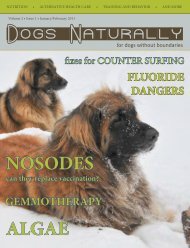For Dogs Without Boundaries - Dogs Naturally Magazine
For Dogs Without Boundaries - Dogs Naturally Magazine
For Dogs Without Boundaries - Dogs Naturally Magazine
You also want an ePaper? Increase the reach of your titles
YUMPU automatically turns print PDFs into web optimized ePapers that Google loves.
ing in the positive direction was stymied.<br />
“In America, we [had begun]<br />
using human psychology on dogs,”<br />
Millan says in an email. “What was<br />
needed was for humans to learn dog<br />
psychology.”<br />
Perils of punishment<br />
Many veterinary behaviorists believe<br />
punishment-based techniques, like<br />
those seen on the show, could come<br />
back to bite dog owners. The National<br />
Geographic Channel even<br />
posts a warning on the screen during<br />
each episode: “Do not attempt these<br />
techniques yourself without consulting<br />
a professional.”<br />
According to a paper in the May<br />
2009 issue of the Journal of Veterinary<br />
Behavior: Clinical Applications<br />
and Research, attempts to assert<br />
dominance over a dog can increase a<br />
dog’s aggression. Researchers from<br />
the University of Bristol in the United<br />
Kingdom studied dogs in a shelter<br />
for six months, while also reanalyzing<br />
data from previous studies of<br />
feral dogs. Their findings support<br />
those of the Mech at the University of<br />
Minnesota: dogs don’t fight to get to<br />
the top of a “pack.” Rather, violence<br />
appears to be copycat behavior —<br />
something borne of nurture, not nature.<br />
“If your timing is lousy<br />
using positive<br />
reinforcement, the worst<br />
thing that happens is you<br />
get a fat dog.”<br />
In another recent study, around 25<br />
percent of owners using confrontational<br />
training techniques reported<br />
aggressive responses from their<br />
dogs. “The source of dog aggression<br />
has nothing to do with social hierarchy,<br />
but it does, in fact, have to do<br />
with fear,” says Meghan Herron, a<br />
veterinarian at The Ohio State University<br />
and lead author of the study<br />
published in the January 2009 issue<br />
of Applied Animal Behavior Science.<br />
“These dogs are acting aggressively<br />
as a response to fear.”<br />
<strong>Dogs</strong> react physiologically to stress<br />
and fear in the same way people do,<br />
with hormones. Two 2008 studies<br />
out of Hungary and Japan showed,<br />
respectively, that concentrations of<br />
the stress hormone cortisol increased<br />
in dogs that were strictly<br />
disciplined and that levels were<br />
linked to elevation of aggressive behavior.<br />
What’s more, an Irish study<br />
found that physically or verbally reprimanding<br />
a dog with a history of<br />
biting people was one of the significant<br />
predictors of a subsequent bite.<br />
The results were published in April<br />
2008 in Applied Animal Behavior Science.<br />
“[All these studies] confirm what<br />
many of us have said for a long time,”<br />
says Pat Miller, owner of Peaceable<br />
Paws dog and puppy training in<br />
Hagerstown, Maryland. “If you use<br />
aggression in training your dog,<br />
you’re likely to elicit aggression<br />
back.”<br />
Paybacks of positive reinforcement<br />
Before practicing professionally as a<br />
dog trainer, Jolanta Benal of Brooklyn,<br />
New York, learned the difference<br />
between positive and punitive methods<br />
personally.<br />
Her dog, Mugsy, had an attraction to<br />
men in uniform. Whether they were<br />
wearing UPS brown or U.S. Postal<br />
Service blue, Benal's bulldog would<br />
lunge at them on the street. So she<br />
hired a highly recommended dog<br />
trainer to try to correct this behavior.<br />
“He would set Mugsy up to do offending<br />
behavior, and then throw a<br />
can full of pennies at the dog,” she<br />
says. “It was a traditional old school<br />
technique. And it worked to suppress<br />
the problem behavior — at least in<br />
the moment.” Mugsy’s unhealthy<br />
obsession with the postal workers,<br />
however, did not go away. Even if he<br />
didn’t always jump at the UPS guy on<br />
a walk-by, says Benal, he wasn’t<br />
happy to see him either.<br />
Benal then traded in for a new<br />
trainer that brought chicken instead<br />
of coins. As the man in uniform approached,<br />
Benal was now instructed<br />
to distract Mugsy by giving him the<br />
treat. And it worked. After several<br />
times, the dog would look to her in<br />
expectation, rather than towards the<br />
uniform-clad men in alarm. “<strong>For</strong> the<br />
last year of his life, he was an angel,”<br />
says Benal. “It was amazing the<br />
changes it brought.”<br />
Millan argues that using food to coax<br />
dogs may be impractical: “It can result<br />
in an addiction to treats or an<br />
overweight dog,” he says in an email.<br />
However, Dodman of Tufts University<br />
explains that trainers only give<br />
food at the beginning of training.<br />
After a period of time, owners should<br />
reward intermittently, reinforcing<br />
the response. “If every time you<br />
played the lottery you won money,<br />
then the excitement wouldn’t be<br />
there anymore,” says Dodman. “The<br />
www.dogsnaturallymagazine.com January/February 2010 | 33












